
The Standardbred is an American horse breed best known for its ability in harness racing, where members of the breed compete at either a trot or pace. Developed in North America, the Standardbred is recognized worldwide, and the breed can trace its bloodlines to 18th-century England. They are solid, well-built horses with good dispositions. In addition to harness racing, the Standardbred is used for a variety of equestrian activities, including horse shows and pleasure riding, particularly in the Midwestern and Eastern United States and in Southern Ontario.

The Icelandic horse is a breed of horse developed in Iceland. Although the horses are small, at times pony-sized, most registries for the Icelandic refer to it as a horse. Icelandic horses are long-lived and hardy. In their native country they have few diseases; Icelandic law prevents horses from being imported into the country and exported animals are not allowed to return. In addition to the gaits of walk, trot, and canter/gallop typical of other horse breeds, many Icelandic horses can also do the tölt and the flying pace. The only breed of horse in Iceland, they are also popular internationally, and sizable populations exist in Europe and North America. The breed is still used for traditional sheepherding work in its native country, as well as for leisure, showing, and racing.

The Clydesdale is a Scottish breed of draught horse. It is named for its area of origin, the Clydesdale or valley of the River Clyde, much of which is within the county of Lanarkshire.

The Morgan horse is one of the earliest horse breeds developed in the United States. Tracing back to the foundation sire Figure, later named Justin Morgan after his best-known owner, as well as mares of the now-extinct Narragansett Pacer breed, Morgans served many roles in 19th-century American history, being used as coach horses and for harness racing, as general riding animals, and as cavalry horses during the American Civil War on both sides of the conflict. Morgans have influenced other major American breeds, including the American Quarter Horse, the American Saddlebred, the Tennessee Walking Horse, and the Standardbred.

The Percheron is a breed of draft horse that originated in the Huisne river valley in western France, part of the former Perche province, from which the breed takes its name. Usually gray or black in color, Percherons are well-muscled, and known for their intelligence and willingness to work. Although their exact origins are unknown, the ancestors of the breed were present in the valley by the 17th century. They are believed to descend from war horses. Over time, they began to be used for pulling stagecoaches; and later, for agriculture and hauling heavy goods. In the late 18th and early 19th centuries, Arabian blood was added to the breed. Exports of Percherons from France rose exponentially in the late 19th century, and the first purely Percheron stud book was created in France in 1893.
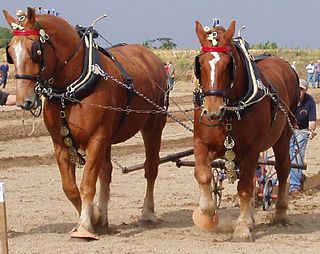
The Suffolk Horse, also historically known as the Suffolk Punch or Suffolk Sorrel, is an English breed of draught horse. The first part of the name is from the county of Suffolk in East Anglia, and the word "Punch" is an old English word for a short stout person. It is a heavy draught horse which is always chestnut in colour, traditionally spelled "chesnut". Suffolk Punches are known as good doers, and tend to have energetic gaits.

The Cleveland Bay is a breed of horse that originated in England during the 17th century, named after its colouring and the Cleveland district of Yorkshire. It is a well-muscled horse, with legs that are strong but short in relation to the body. The horses are always bay in colour, although a few light hairs in the mane and tail are characteristic of some breed lines. It is the oldest established horse breed in England. The ancestors of the breed were developed during the Middle Ages for use as pack horses, when they gained their nickname of "Chapman Horses". These pack horses were cross-bred with Andalusian and Barb blood, and later with Arabians and Thoroughbreds, to create the Cleveland Bay of today. Over the years, the breed became lighter in frame as they were employed more as carriage and riding horses. The popularity of the Cleveland Bay has greatly fluctuated since it was first imported to the United States in the early nineteenth century. Despite serious declines in the population after the Second World War, the breed has experienced a resurgence in popularity since the 1970s, although only around 550 horses existed worldwide as of 2006.

The Narragansett Pacer was one of the first recorded horse breeds developed in the United States. It emerged in the 18th century (1700s), and was theorized to have been bred from a mix of English and Spanish breeds, although the exact cross is unknown. The Pacer was associated with, and bred in, the state of Rhode Island and the area of New England; as horse breeding shifted to Kentucky and Tennessee in the late 1700s, it became extinct by the 20th century.

The Dales Pony is a British breed of pony or small horse. It originated in, and is named for, the Dales of Yorkshire in northern England. It is one the nine native mountain and moorland pony breeds of the United Kingdom, and belongs to the broader Celtic group of ponies which extends from Portugal and northern Spain to Scandinavia.

The Dole Gudbrandsdal, Dølahest, or Dole is a draft- and harness-type horse from Norway. The Dole Trotter is alternately considered a subtype of the Dole Gudbrandsdal and a separate breed; it is also considered a part of the coldblood trotter type. The Dole Gudbrandsdal is a small draft horse, known for its pulling power and agility, while the Dole Trotter is a smaller, faster horse used for harness racing; the two types are commonly interbred. Both types are strictly critiqued before entry into the studbook, which has over time resulted in an improvement in the breed type. The Dole is originally from the Gudbrandsdal Valley, and is probably descended in part from the Friesian horse. Over time, the breed has had Thoroughbred, Arabian, and other breeds added in, especially during the creation of the Dole Trotter in the 19th century. The first studbook was created in 1941, and the current breed association was formed in 1947. Although originally used mainly as a pack horse, today, the heavier Dole type is used mainly for agricultural purposes. The Dole Gudbrandsdal been crossed with other breeds to develop horses for harness racing and riding.
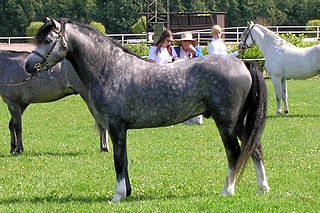
The Welsh Pony and Cob is a group of four closely-related horse breeds including both pony and cob types, which originated in Wales in the United Kingdom. The four sections within the breed society for the Welsh breeds are primarily distinguished by height, and also by variations in type: the smallest Welsh Mountain Pony ; the slightly taller but refined Welsh Pony of riding type popular as a children's show mount; the small but stocky Welsh Pony of Cob Type, popular for riding and competitive driving; and the tallest, the Welsh Cob, which can be ridden by adults. Welsh ponies and cobs in all sections are known for their good temperament, hardiness, and free-moving gaits.
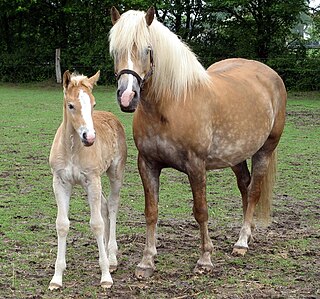
The Haflinger, also known as the Avelignese, is a breed of horse developed in Austria and northern Italy during the late 19th century. Haflinger horses are relatively small, are always chestnut with flaxen mane and tail, have distinctive gaits described as energetic but smooth, and are well-muscled yet elegant. The breed traces its ancestry to the Middle Ages; several theories for its origin exist. Haflingers, developed for use in mountainous terrain, are known for their hardiness. Their current conformation and appearance are the result of infusions of bloodlines from Arabian and various European breeds into the original native Tyrolean ponies. The foundation sire, 249 Folie, was born in 1874; by 1904, the first breeders' cooperative was formed. All Haflingers can trace their lineage back to Folie through one of seven bloodlines. World Wars I and II, as well as the Great Depression, had a detrimental effect on the breed, and lower-quality animals were used at times to save the breed from extinction. During World War II, breeders focused on horses that were shorter and more draft-like, favored by the military for use as packhorses. The emphasis after the war shifted toward animals of increased refinement and height.
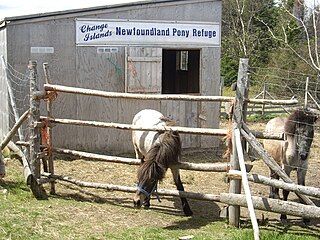
The Newfoundland pony is a breed of pony originating in Newfoundland, Canada. They are sturdy and muscular ponies, found in many colors, including the relatively rare white coloration. The Newfoundland developed from a mix of English, Irish and Scottish pony breeds brought to Newfoundland by settlers over a period of four centuries. Initially free-roaming, they crossbred to produce the modern type. They were used by settlers as draft and multi-purpose ponies until the mid-20th century, when they were brought almost to the point of extinction by mechanization and slaughter. The population rebounded slightly after the formation of a breed registry in 1980, but still remains low. In 1997, the Newfoundland pony was declared a heritage breed of Newfoundland and Labrador, which afforded it protection under the law, but the breed has not yet been recognized under the Canadian federal Animal Pedigree Act. As of 2008, there were 248 registered ponies of breeding age, out of a total population of 361. In 2013, the widely dispersed breeding population is still estimated at between 200 and 250 animals.
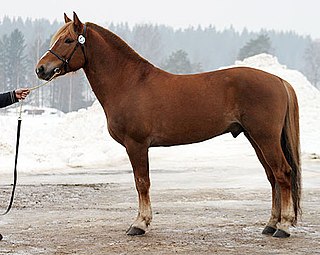
The Finnhorse or Finnish Horse is a horse breed with both riding horse and draught horse influences and characteristics, and is the only breed developed fully in Finland. In English it is sometimes called the Finnish Universal, as the Finns consider the breed capable of fulfilling all of Finland's horse needs, including agricultural and forestry work, harness racing, and riding. In 2007, the breed was declared the official national horse breed of Finland.
The Colorado Ranger is a horse breed from the Colorado High Plains in the United States. The breed is descended from two stallions imported from Turkey to the US state of Virginia in the late 1800s. These stallions were then bred to ranch horses in Nebraska and Colorado, and in the early 1900s the two stallions who every registered Colorado Ranger traces to, Patches #1 and Max #2, were foaled. The breed was championed by rancher Mike Ruby, who founded the Colorado Ranger Horse Association in 1935. Original registry membership limits resulted in many Colorado Ranger horses being registered instead as Appaloosas, but pedigree research is ongoing to discover additional horses who trace their ancestry back to the original stallions.

The Irish Draught horse is the national horse breed of Ireland which developed primarily for farm use. Today, they are especially popular for crossing with Thoroughbreds and warmbloods, producing the popular Irish Sport Horses which excel at the highest levels of eventing and show jumping.

The American Warmblood is a horse of warmblood type, intended primarily for the traditional sport horse disciplines of dressage, show jumping, eventing and combined driving.
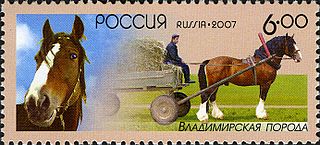
The Vladimir Heavy Draft is a Russian breed of heavy draught horse. It was bred in the early twentieth century in farms and collectives in Ivanovo Oblast and Vladimir Oblast, to the east of Moscow. The most important influence on the development of the breed was from three Clydesdale stallions foaled between 1910 and 1923. The Vladimir was officially recognised in 1946.

The Poitevin or Poitou is a French breed of draft horse. It is named for its area of origin, the former province of Poitou in west-central France, now a part of the region of Nouvelle-Aquitaine. It was formed in the seventeenth century when horses of Flemish or Dutch origin, brought to the area by engineers working to drain the Marais Poitevin, interbred with local horses. Although it has the size and conformation of a draft horse, the Poitevin has never been bred for draft abilities, and has been little used for draft work. Its principal traditional use was the production of mules. Poitevin mares were put to jacks of the large Baudet du Poitou breed of donkey; the resulting Poitevin mules were in demand for agricultural and other work in many parts of the world, including Russia and the United States. In the early twentieth century there were some 50,000 brood mares producing between 18,000 and 20,000 mules per year.

The Heck horse is a horse breed that is claimed to resemble the tarpan, an extinct wild equine. The breed was created by the German zoologist brothers Heinz Heck and Lutz Heck in an attempt to breed back the tarpan. Although unsuccessful at creating a genetic copy of the extinct species, they developed a breed with grullo coloration and primitive markings. Heck horses were subsequently exported to the United States, where a breed association was created in the 1960s.





















